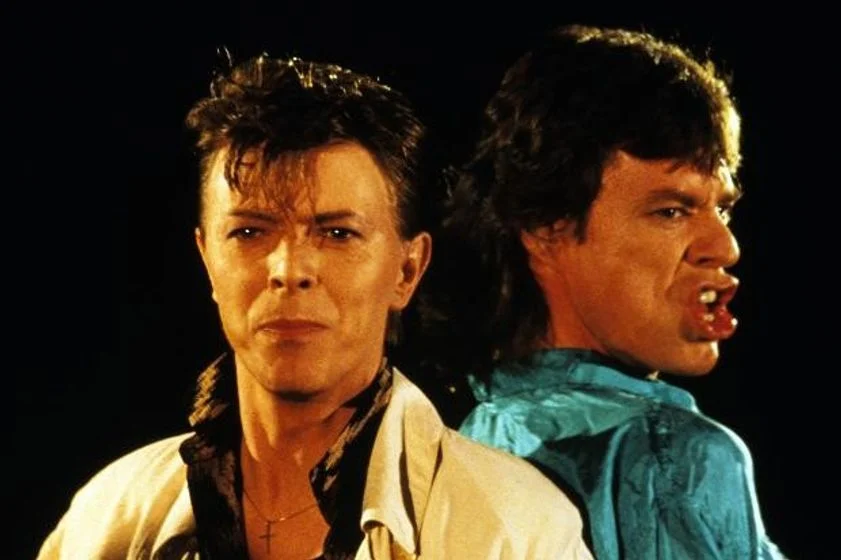The Close Connection Between David Bowie and Mick Jagger
When David Bowie embarked on his musical journey in the 1960s, he aimed to capture the essence of The Rolling Stones’ sound.
While he didn’t quite achieve that goal, he still managed to create a vibe reminiscent of the era.
Bowie and Jagger’s relationship was filled with theatrics, designed to both shock and entertain.
Although they shared a certain closeness, there was an underlying tension between the two.
It may sound unusual, but their bond resembled that of brothers, albeit an unconventional one.
Bowie admired Jagger and considered him to be the epitome of cool.
He even referred to Jagger as a mother figure, describing him as more of a brothel-keeper or madame rather than a typical rock star.
Jagger, on the other hand, reciprocated the affection but also felt a tinge of envy towards Bowie.
In an interview with NME in 1974, Jagger confessed, “I wonder how long he’s going to last…
I really shouldn’t talk about Bowie because I know him too well and know his fears and his hauntings.”
During the early stages of his career, Bowie idolized Jagger, especially evident in his 1973 album “Aladdin Sane,” which drew inspiration from Jagger’s bold statement that true performance is achieved through madness.
As time went on, Jagger found himself wanting to emulate Bowie’s ability to constantly reinvent himself, realizing his own lack of transformation in comparison.
Bowie even covered a Rolling Stones song on “Aladdin Sane” as a tribute to Jagger and the band.
His version of “Let’s Spend The Night Together” was flamboyant and amped up, reflecting Bowie’s unique style.
The song was initially released as the B-side to “Ruby Tuesday” in Britain in 1967, later included on the American release of the album “Between The Buttons.”
In many ways, “Aladdin Sane” can be seen as an homage to Jagger and the Rolling Stones.
The opening track, “Watch That Man,” showcases Bowie’s attempt to sing like Jagger.
While Bowie admired several successful musicians, it was Mick Jagger who held a special place in his heart during his early obsession with rock ‘n’ roll.
Bowie’s greatest strength, his ability to constantly transform himself, was also his weakness.
His fear of inheriting the schizophrenic gene from his mother’s side of the family, coupled with his brother Terry’s struggle with mental illness, contributed to Bowie’s constant search for identity.
Mental illness and the notion of being “crazy” were recurring themes throughout Bowie’s work.
He often admitted to borrowing ideas and qualities from others, feeling like a collection of other people’s thoughts rather than an individual with a distinct identity.
Bowie expressed a sense of lacking in his life, unable to pinpoint exactly what it was.
In 1985, Jagger and Bowie playfully parodied their fascination with one another by collaborating on a duet of “Dancing In The Street.”
The proceeds from the record and music video went towards the Live Aid famine relief fund.
On the surface, it seemed innocent and whimsical, but underlying s**ual tension could be detected in their performance.
The collaboration became a huge success, topping the charts in the UK and reaching number seven in the US.
Directed by David Mallet, the music video further elevated its popularity.
The question remains: How far did their relationship truly go?
Let’s delve into the facts.
Were David Bowie and Mick Jagger lovers?
Bowie and Jagger’s relationship was undoubtedly a spectacle, driven by their desire for media attention.
While they explored their sexualities together, it was more a reflection of the countercultural attitudes of the time rather than a deliberate artistic statement about their s**ual orientations.
According to Christopher Andersen, author of “Mick: The Wild Life and Mad Genius of Jagger,” Bowie and Jagger were frequently seen together without their wives, attending various events and concerts.
There was undoubtedly a romantic element to their connection, with reports suggesting that they engaged in numerous s**ual encounters involving threesomes.
Backing singer Ava Cherry confirmed her involvement as one of the “third wheels,” admitting to witnessing their intimate moments.
Playboy model Bebe Buell also revealed her experiences with both men, recounting strange late-night phone calls from Jagger and Bowie, inviting her to join them in bed with either four gorgeous black women or four gorgeous black men.
Perhaps the most infamous incident involving Bowie’s alleged same-s** affairs occurred in 1973 when his ex-wife, Angie, claimed to have discovered him and Jagger in bed together.
She stated, “They were n^ked.”
Angie walked into the bedroom after returning from a trip and found Bowie hidden under pillows and duvets, with Jagger’s leg visible on the other side of the bed.
Despite the intimate scene she stumbled upon, Angie described it as more drunken pawing than a passionate love affair.
While it may not have been a serious romantic relationship, Angie did acknowledge that she caught Bowie in bed with other men on multiple occasions.
She commented, “There are two ways of looking at that incident.
One is that it was just a typical London scene: best friends stumbling home drunk or stoned from a night out, undressing and passing out in bed.
The other perspective suggests that both musicians craved attention and treated their sexuality as performance art.
Bowie embraced the ambiguity surrounding his sexuality, knowing that if it were no longer a mystery, the media would lose interest.
The complex relationship between David Bowie and Mick Jagger remains a subject of fascination.
While their connection was undoubtedly significant, it is important to view it within the context of the era and the countercultural attitudes that prevailed.
Their relationship transcended traditional labels and boundaries, ultimately becoming an integral part of their respective artistic identities.































